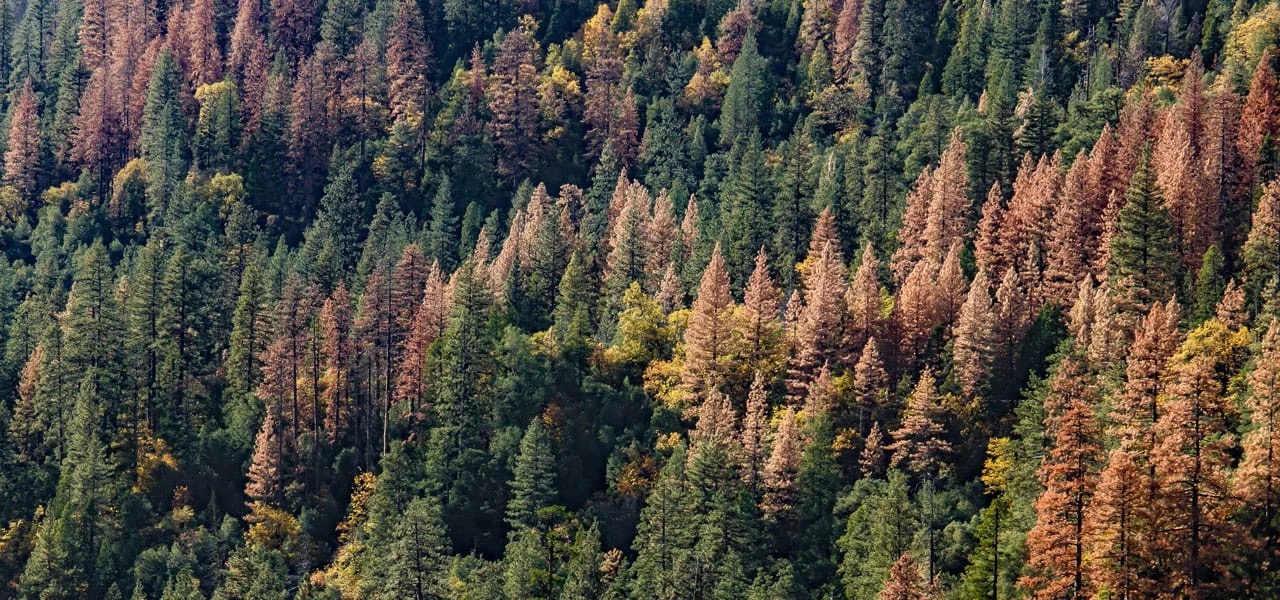At a Glance
Height: 15-35 feet or 65-80 feet in favorable conditions
Spread: 25-40 feet
Shape: Pyramidal to rounded
Exposure: Full Sun
Native? Yes
Evergreen? Yes
Leaves: Dark green to bluish needles, 1 ½” to 2 ¾” long, smooth in both directions, usually grows in bundles of five needles
Fruit: Cones – can be distinguished because they fall to the ground without disintegrating. 3 to 6 inches long, oval, no bristles. Mature cones have resin on the ends of each scale.
Firewise? No. Young, thin bark is not firewise but older trees have bark that can be 2 inches thick, providing some protection. Lower limbs may need to be pruned.
Drought-tolerant? Yes.
Bark: Pale gray and smooth when young (trunk less than 6 inches in diameter), reddish-brown and scaly on older trees, especially when exposed to the elements
Where to Plant: Well-drained soil and full sun. Choose carefully – this tree can be difficult to transfer once established because of a large taproot.
Common Problems & Possible Causes
White pine blister rust (Cronartiumribicola)
Fungal diseases such as limber pine dwarf mistletoe (Arceuthobium cyanocarpum)
Cone beetles
Coneworms
About Limber Pines

“Limber” refers to the tough, flexible branches that make up the limber pine – often, they can be bent back on themselves without breaking.
Cones
It can be hard to differentiate limber pines from whitebark pine (P. albivaulis) and Western white pine (P. monticola). One of the best ways to identify limber pines is by their cones – if the cones fall to the ground intact, they are probably from a limber pine tree.
Size
The size of limber pines depends on where they are grown. In the high elevation environment where it is typically found, it can appear more like a shrub or multi-stemmed tree and may only grow to 20 feet tall, adding just a few inches every year. In lower elevations, it will grow much more quickly (by 8-10 inches a year) and can be taller than 30 feet.
Growth
This ability to grow faster or slower points to its drought adaptability – in periods of drought, the limber pine will slow down its growth rate.
Scent
The scent of limber pine has been dubbed “the fragrance of the mountains.” Planting one on your property will bring the added benefit of a naturally pine-scented yard.

Limber pines get their name from their needles, which are so limber that they can be bent backward without breaking
Where Limber Pines are Found
Limber pines are naturally found on rocky hills at higher elevations. They don’t mind poor or rocky soil, windy areas, or cold temperatures, so they are often found in places where other trees may not be able to grow.
Limber pines can also grow amongst lodgepole pines and ponderosa trees, and in some rare cases, can even be found growing below 5,000-foot elevation.

Limber pines can often be recognized by their pine cones, which are an important food source for wildlife
Oldest Limber Pine
Some Colorado limber pines are more than 1,000 years old. There is one in South Park, Colorado that is estimated be to around 1,660 years old.
One of the oldest limber pines is in Alberta, Canada. It has a girth of 185 inches and scientists estimate that it is close to 3,000 years old.
Unique Shapes
Similar to bristlecone pine, older trees can be sculpted by wind and rain into an irregular, twisty shape. While limber pines and bristlecone pines are sometimes found in the same area and have similar characteristics, the limber pines will grow taller – and there are usually more of them.

Limber Pines and Clark’s Nutcrackers
Because the cones of the limber pine tree don’t break on their own, seeds are trapped inside the cone and cannot be easily distributed. This means that the limber pine does not naturally reseed as some other trees and plants do. Instead, it is dependent on birds such as nutcrackers, and specifically, Clark’s nutcracker, which is able to break open the cone and get to the seeds. The bird then buries the seeds in the ground to store as winter food. When those seeds are left undisturbed, they can grow into a new tree.
This system is beneficial for the nutcracker as well, as the seeds are its only winter food. Some estimates say that a Clark’s nutcracker collects as many as 20,000 to 30,000 seeds from limber pines from August to November each year.
Red squirrels also eat the seeds, and there have been cases where American black bears eat the limber pine nuts that red squirrels have hidden.
Contact the tree care professionals at LAM Tree Service if you’d like to add a limber pine, or any other type of tree, to your property.
Tree Planting
We recommend spring or early fall planting to get your new trees off to a great start. You can always call us for advice on where to plant your new tree(s) and don’t forget that we offer professional tree planting services if you don’t want to do it yourself!
Recommended Trees & Shrubs
Get A Free Quote
Call us at 303-674-8733 or contact us online to get a free estimate for tree planting, general tree services or any aspect of our Plant Health Care program.
























